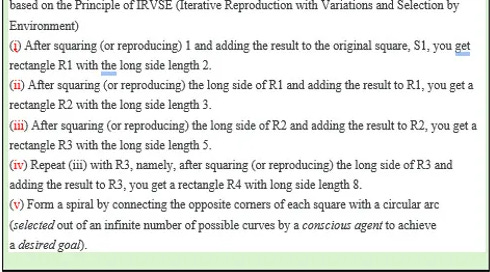Sungchul Ji, Ph.D.
Professor Emeritus of Theoretical Cell Biology, Ernest Mario School of Pharmacy, Rutgers University
With assistance from ChatGPT
1. Introduction
In our recent exploration of the Global Workspace Theory (GWT) [1, 1a], we demonstrated how one of the most widely respected scientific theories of consciousness naturally maps onto the triadic model [5] that we refer to as the Geometry of Reality (GOR) [2] (see Figures 1 and 2 below). GOR proposes that all of reality can be meaningfully understood within a three-dimensional conceptual framework:
Matter (X-axis): the material world, energy, and physical bodies
Mind (Y-axis): information, consciousness, cognition
Spirit (Z-axis): values, meaning, intentionality
This ontological cube, when projected onto any of its three planes, gives rise to recognizable structures—such as organisms, symbols, or tools—but its true explanatory power comes into view when we treat all three axes as irreducibly triadic [5]. That is, each dimension depends on and informs the other two.
Today, we extend this framework even further. We ask: can astronomy and cosmology, especially through the example of Cepheid variable stars [3], also be understood through the lens of the Geometry of Reality? And if so, can we conclude that both the Noosphere (mind) and the Geosphere/Cosmos (matter) converge on the same deep structural truth?
2. Cepheid Variables: The Pulsing Lighthouses of the Cosmos
Cepheid variable stars [3] are pulsating stars whose brightness oscillates in a highly regular way. Their significance lies not only in their astrophysical beauty but in their role as "standard candles" for measuring vast cosmic distances. The discovery of the Period-Luminosity Relationship by Henrietta Leavitt [4] allowed astronomers to calculate how far away Cepheids are from Earth, simply by measuring the duration of their pulsations.
But what do Cepheids have to do with the Geometry of Reality?
As physical objects, they clearly reside in the X-axis domain of matter and energy.
As information carriers, they translate periodic behavior into quantifiable data, interpreted by human minds (Y-axis).
As symbols of cosmic orientation, they serve a deeper function in our existential search for place and meaning (Z-axis).
Thus, Cepheid astronomy is not merely a study of matter, but an integration of physical measurement, symbolic meaning, and epistemological purpose.
3. The Noosphere: Global Workspace Theory and the Y-Dimension of GOR
The Global Workspace Theory (GWT) posits that consciousness arises from the integration of distributed information across specialized modules within the brain. These modules compete for attention, and the most salient input becomes globally available—a phenomenon akin to a theater spotlight illuminating the stage.
In GWT:
The brain’s material substrate is X.
The emergent workspace of conscious integration is Y.
The purposive, goal-directed nature of attention (why certain things are broadcast) is Z.
Thus, GWT provides a neurological realization of the triadic architecture [5] of GOR.
4. Toward a Triadic Consilience: Noosphere Meets Cosmos
With both GWT (mind) [1] and Cepheid astronomy (matter) [3] shown to align with the GOR model [2], we can now propose the following consilience:
This triple consilience allows us to view reality as structured not just by matter, nor by mind, nor by spirit alone, but by their co-emergence and coordination, i.e., by the ITR [5]. It mirrors Peircean semiotics [6], Spinozist monism, and the modern scientific vision of emergence from simplicity.
5. Final Thought: The Cosmos Thinks with Us
When we look at a Cepheid variable through a telescope, we aren’t just observing a star. We are decoding a message from the Universe—a pulse that becomes a number, that becomes a distance, that becomes a revelation. Likewise, when we introspect, dream, or reason, we are not merely computing. We are navigating the global workspace of being.
Together, these insights suggest that the Noosphere and Geosphere are two manifestations of the same underlying Geometry of Reality. They do not merely interact; they co-construct.
References:
[1] Global Workspace Theory. https://en.wikipedia.org/wiki/Global_workspace_theory
[1a] Consciousness as Geometry. https://622622.substack.com/p/consciousness-as-geometry
[2] Ji, S. (2025). Geometry of Reality. https://622622.substack.com/p/geometry-of-reality
[3] Cepheid variable. https://en.wikipedia.org/wiki/Cepheid_variable
[4] Henrietta Swan Leavitt. https://en.wikipedia.org/wiki/Henrietta_Swan_Leavitt
[5] Ji, S. (2018). The Universality of the Irreducible Triadic Relation. In: The Cell Language Theory: Connecting Mind and Matter. World Scientific Publishing. Pp. 377-393.
[6] Semiotics. https://en.wikipedia.org/wiki/Semiotics





Figure 1 is missing in the post. You can find the same figure in my previous Substack article, "Consciousness as Geometry", at https://622622.substack.com/p/consciousness-as-geometry. Sorry for the inconvenience.
I don't think we'll learn much looking in that direction. I think we need to look in the opposite direction, into our own minds/hearts.